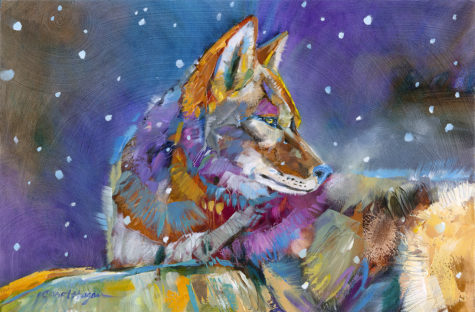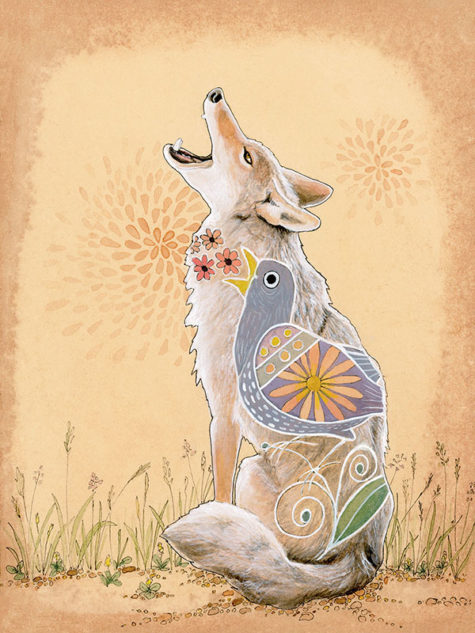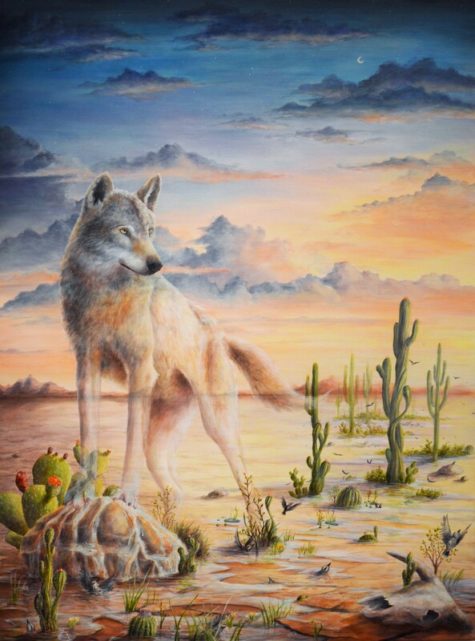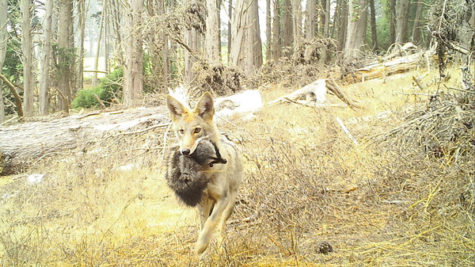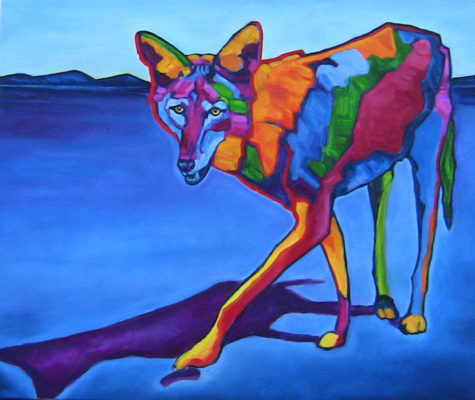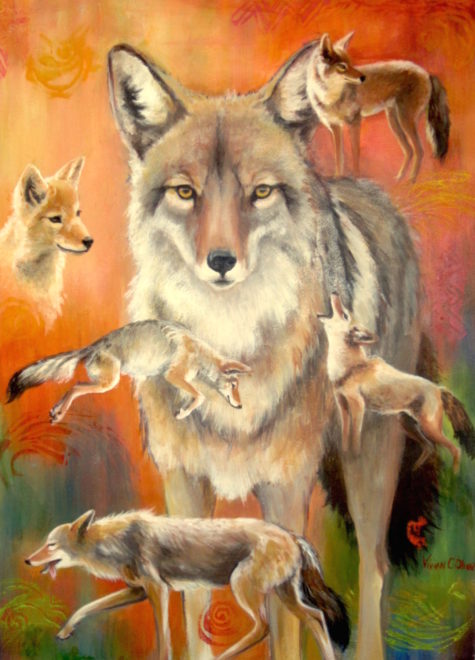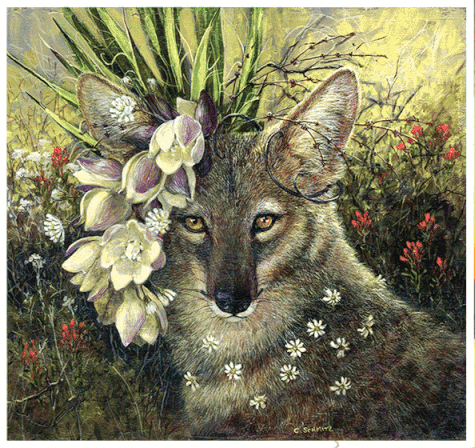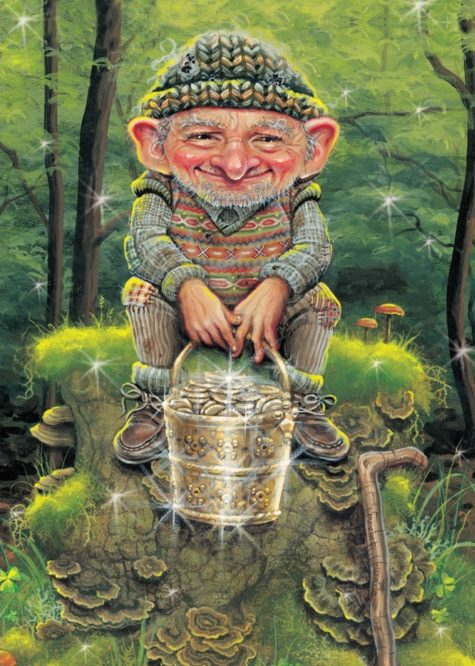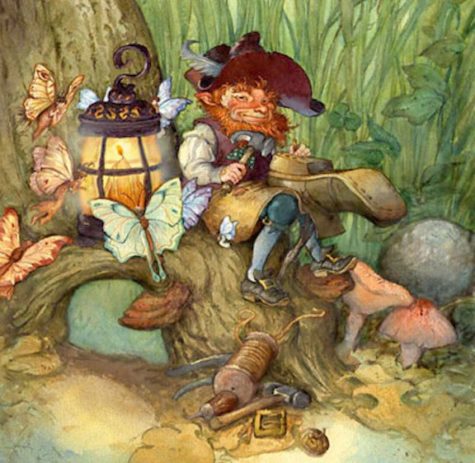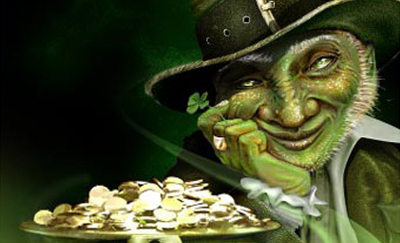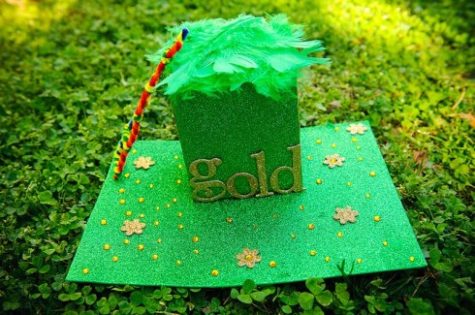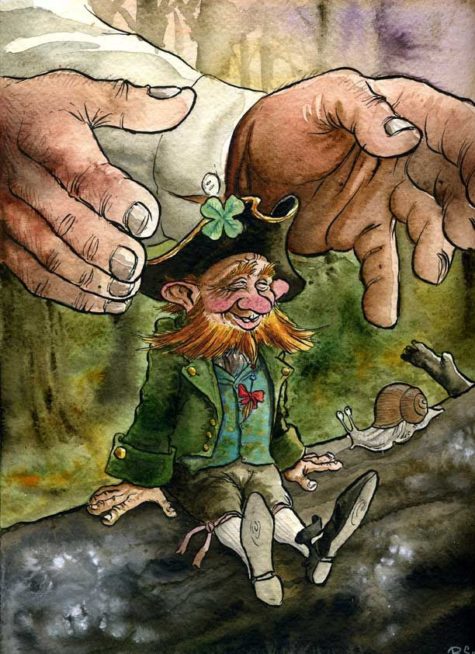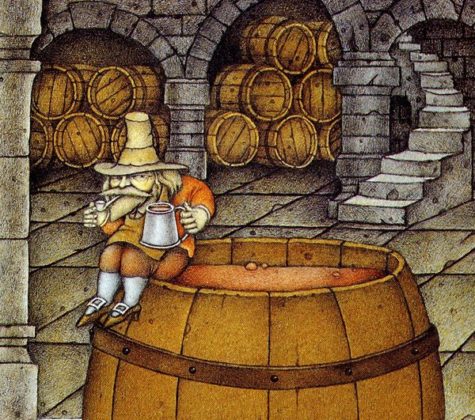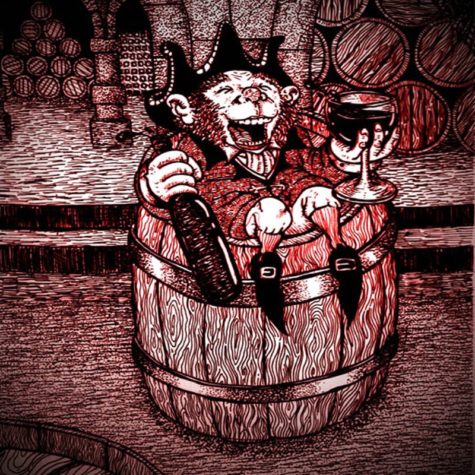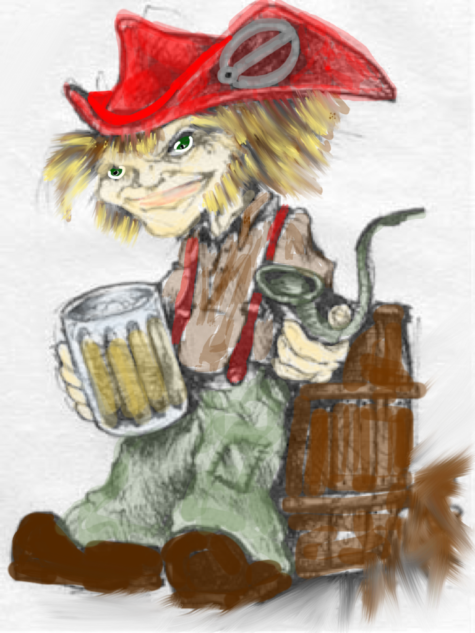Tricksters
The Coyote is one of the sacred animals that can open the door to the other world and it acts as a messenger between this world and the next.
- Keynote: Wisdom and Folly
- Cycle of Power: Year-round
The coyote spirit animal makes its presence known when you feel like you have lost your way.
The Coyote shares many of the characteristics of the Fox. It is the trickster God, the miracle-worker, the shape-shifter, and as such plays an important part in Native American belief. Because Coyotes can be heard howling at night they are often associated with the Moon.
The Coyote is an amazingly adaptive animal, and the Native American lore about this animal is rich and plentiful. It is the creator and the jokester. Much magick has been associated with the Coyote, but the magick does not always work. Even in its not working, it serves a purpose. There is always hidden wisdom where the Coyote is concerned.
In many ways the Coyote is to the plains Indians what the raven is to the people of the Northwest ~ creator, teacher, and keeper of magick. Both are playful and love to have fun. Both are skillful, but often look for ways to do things that will not involve the use of their own skill. They often look for short cuts. Both remind us not to become too serious, and both remind us that anything is possible.
Oftentimes in many of the tales, the Coyote makes things more complicated than they need to be. If Coyote has shown up as a totem, you may wish to ask yourself some questions:
- Are you and those around you being too serious?
- Have you forgotten that play time is essential to health?
- Are you complicating what is really simple in some are of your life?
- Is someone playing tricks on you?
The Coyote teaches the balance of wisdom and folly and how they both go hand in hand. The image of the wise fool has been used in the lore of many societies. This is the individual who seems to be a simpleton and yet the words and actions have a much greater wisdom than is initially recognized. Are you not seeing the wisdom of your life and its events? The Coyote will help you.
If Coyote has appeared for you, it’s time to find the humor and laughter in the lessons of life so that you will continue to appreciate it for the exciting and unpredictable adventure that it is! When you learn to laugh at your mistakes and disappointments, there are only life lessons and experiences, and a whole lot of possibilities.
Call on your Coyote Spirit Animal when:
- You need to inject more humor into your life.
Life doesn’t have to be so serious and somber all the time. Laugh at yourself, and don’t let life get you down! - You want to gain more wisdom and understanding of how the world works.
Life is a big puzzle which you will eventually understand the more that you experience it. Do not be afraid of change because this will give you meaningful lessons. - You want to fully experience life!
Sometimes you need to throw caution to the wind and live each day as it comes. Be present in the moment because life is too short.
In the tarot deck is The Fool card. This card is good for anyone with a Coyote totem to meditate upon. Its energies are tied to simplicity and trust. It is the card for developing poise in the chaos of life. It stimulates and renews innocence, and it reawakens a childlike wisdom in response to the world. It is the card that reminds us that true teachers of wisdom have a wonderful sense of humor. Through the Coyote, we learn to become again as little children with a reawakening of the intellect, creativity, the artistic mind, and all of the intuitive faculties.
The Spirit Keeper of the South is represented by the Coyote, that wild and wily teacher of the animal kingdom. There is a whole body of Native mythology dealing with the Coyote, the old trickster who is sometimes Creator and sometimes sacred clown. The Coyote is the most sacred and most profane of animals. Like loon and frog, he is a powerful singer whose song can move humans to freedom or to fear. Coyote brings growth to everyone, but to those who love life he gives the gift of trust. It is trust in life that teaches true survival and real endurance.
When he serves as Shawnodese, The Spirit Keeper of the South, the Coyote’s coat is the mottled color of the sun at midday shining on the earth. Sometimes when serving with Shawnodese the Coyote’s coat is so mottled he seems to disappear. It is then he does his most powerful work.
Coyote can be found in many rural settings in North America. Smaller than a wolf, the Coyote has proven adaptable to the onslaught of civilization. Coyote’s most distinguishing attributes are his swiftness, sharp senses, doglike features, and song. On many evenings in the country, the yipping and howling of Coyote pierces the quiet night, reminding all the two-leggeds who can hear that although they now predominate on earth, they are not the only species in existence.
Of all the figures in Navajo life and mythology, Coyote (Maii’) is the most contradictory and delightful animal. Coyote is considered a god, a trickster, and an evil spirit. He cannot be killed because he is powerful and contradictory.The Coyote is important in traditional Navajo life. Coyote always seems to be hiding or lurking just out of view. He is a shadowy figure that can be funny or fearsome.
Although often seen as a pest to be eliminated by many groups, it has managed to extend its range. It is found in every part of the country. It has been able to do so because it has used its keen intelligence and adaptive ability. The Coyote used to be most active hunting at dawn and dusk. Today it is most active at night. This is done to avoid other hunters.
The Coyote will often use cooperative hunting techniques. They have a well organized system of running down smaller prey. The chase occurs in relays. While one Coyote rests, another gives chase. This kind of cooperation hints at the energies that Coyote can bring to your life ~ an ability to stimulate cooperation to accomplish important tasks in the most efficient manner. Sometimes the Coyote has even teamed up with badgers and they have hunted together, reflecting the Coyote’s ability to adapt to the situation.
The howl is one of the Coyote’s most significant qualities. It is generally accepted to be primarily a social gesture. It can express loneliness, warn of danger, or call for assistance. It touches the soul of whoever hears, reminding us of our primal connections.
A Coyote’s den can be located anywhere. They usually prefer the side of a hill near a water source. The Coyote will often return to the same den for each litter, but they rarely use the den year-round. It is a place they work out of. This same kind of pattern is common among those who have a Coyote as a totem. They are most effective when they work from a place, but do not limit themselves strictly to it. It hints of the need for mental stimulation, and those with this totem require a lot of it.
Coyote’s have a very close-knit family unit. They will sometimes mate for life. The father is very conscientious and participates in the care and raising of the young. Both parents train the young in hunting techniques. The male cares for the mate, while she is pregnant, helping to protect and feed her. If something does happen to the mother, then the male takes over the care of the young.
The Coyote is one of the most fascinating animals, and it is not easily locked into any particular category. It is filled with paradox, but at the heart of its energy is the balance of wisdom and folly that makes for a fulfilling life.
Coyote Superstition and Taboos
The Coyote is sometimes held responsible for all the evils of the world, and in the countries where it makes its home it is generally a symbol of bad luck.
How people react to Coyote teaches a lot about them. Those who love life and the earth are inspired by Coyote’s song and his ability to outsmart the civilization that has tried to destroy him. Those who fear all that is natural also fear Coyote and try to destroy him by shooting, poison, or traps. Fearful ones depict Coyote as a thief, one who eats domestic livestock, like chickens. Coyote prefers to eat natural, free-roaming animals like mice or rabbits but he will lunch on an occasional chicken or small domestic animal in areas where civilization has killed all of his natural prey.
Navajos have an omen that can also be considered as a taboo. They say that if Coyote crosses your path, turn back and do not continue your journey. If you keep traveling, something terrible will happen to you. You will be in an accident, hurt, or killed.
Coyote Symbolism
Coyote symbolism has a tendency to be rather powerful in what it is trying to tell you, and if the spirit animal does appear to you in your life, then it will often signify a number of rather important changes or differences that are going to occur.
However, there are a number of clear facts surrounding this particular spirit animal that you may like to be aware of just in case it does end up appearing in your life.
- It appears when you feel you have become lost.
There is nothing more disheartening for an individual than believing that they have become lost with the path that they are following in life.
If that sounds like you, then this may be the time where the coyote spirit animal will appear.
It offers you strength and knowledge that you will get through this period and find your direction once again as you have the ability in your own self to be able to achieve this.
- It is intended to inspire some change in you.
The meaning of the coyote inspires change. If you do the same things over and over, you will pretty much get the same results, and that’s truly no way to live your life!
There has to be a time where you realize that doing the same actions will always lead to the exact same outcome, so the coyote spirit animal is reminding you that this does not always have to be the case.
Instead, you can do something different and see the outcome and whether or not you prefer it to be this way.
The challenge for you by your coyote totem is to do things using new methods, options, and solutions. Out with the old, and in with the new!
Trying new things will help you learn new tricks to succeed in life and win at relationships. A whole world of choices and opportunities will open for you if you start letting go of your old fears and insecurities.
- Let go of sentimental things to get freedom.
When the coyote totem appears to you, it urges you to let go of sentimental attachments and focus on what you are going to do with what you have in the present. What it is trying to do here is to get you to focus on the present and what you have surrounding you right now as that is the most important thing of all.
The coyote meaning reminds you that life is always changing, and nothing ever stays the same. Even if you fight change with all that you have, you should learn to let go of the mental anguish and find a way to laugh it off and make it work.
This rather important idea is that the coyote spirit animal is encouraging you to release yourself from the bind of those items that are not allowing you to then grow as an individual.
- It pushes that there are hidden roads that you do not know of.
The coyote symbolism ushers in a time to find hidden paths that will lead you to where you should be. It’s time to reveal the truths behind the masks, and it’s time to see beyond the illusions.
The coyote is able to wander all over the place, and it finds new roads to travel down, so that is one message that is loud and clear with the coyote spirit animal.
However, it also teaches you that there is no need to be afraid to go down that hidden road even though you may not know what is at the other side as you have the ability to deal with whatever is placed in front of you.
- You may be slightly reckless.
Coyote symbolism is also tied into the idea of you being reckless at times simply because you see some kind of opportunity and you then look at going for it.
This will work in your favor at times, but then it can also work against you as well, so you need to try to weigh up your options as much as possible.
It’s time to do things that bring you joy, contentment, and happiness.
There is no doubt that the coyote spirit animal is a bit more of a free spirit than people are perhaps aware of, but it will also show you to focus on the present rather than being stuck in the past or wondering what the future will be like.
Dreaming About Coyote
The coyote is a complex dream symbol. On one hand, the coyote represents wisdom and being aware of the balance of Nature. It means surviving in all circumstances and maintaining a sense of humor. On the other hand, the coyote is a symbol of weakness, deception, hypocrisy, and meddling in things that aren’t your business.
If your dream includes being attacked by a pack of coyotes, or if several coyotes are threatening you, this is a warning that you need to be very careful and watchful in the near future. If you see a friendly coyote in the dream, it indicates that you are or will be deceived by someone close to you. Alternatively, the friendly coyote suggests that you will be able to get past any troubles that are keeping you from evolving psychologically.
The appearance of a coyote in a dream may symbolize a lack of ambition or a weakness of some kind. It may also indicate that you are attacking those around you who are weaker and can’t defend themselves as well.
Coyotes represent “tricky” and unexpected elements in life. For Native Americans, the coyote is a creator, teacher, and a keeper of magic. The coyote is the Trickster God who appears as the Creator in many creation myths. The coyote is considered to be a messenger who has the ability to change his appearance. The coyote generally represents a sacred power.
If you see a coyote in your dream, it is a reminder to keep your sense of humor and not become overly serious in life. The coyote suggest that you need to learn how to balance wisdom with folly, as represented in some cultures by the figure of the “wise fool.” Coyotes in nature are very cooperative with one another, so the dream coyote may be telling you to be more cooperative with others and that you can accomplish great things through cooperation.
Sources:
- Animal Speak
- Sleep Culture
- Dancing With The Wheel
- Trusted Psychic Mediums
- The Element Encyclopedia of Secret Signs and Symbols
- Origin: Ireland
- Manifestation: Leprechauns are described as small wizened men wearing a shoemaker’s leather apron.
The stereotype of the Leprechaun involves lucky charms and pots of gold at the end of the rainbow. If captured by a human, they often grant three wishes in exchange for their freedom.
Leprechauns are highly commercially modified spirits; their image used to sell breakfast cereal, beer, and anything even remotely Irish. In recent years, Leprechauns, re-envisioned as “evil Fairies” have evolved into villains of horror movies; however this distorted image has no relation whatsoever to true Leprechauns who may be grouchy but are by no means vicious killers.
True Leprechauns are members of the Fairy folk, a type of sidhe. They are unusual because, in a realm dominated by females, Leprechauns are virtually exclusively male spirits.
The name Leprechaun derives from the Gaelic leigh brog “one shoemaker.” He is a cobbler, the only professional sidhe. While the other sidhe are out dancing and reveling, the Leprechaun is hard at work. He is, however, always seen working on only one shoe rather than a pair, which may be a shamanic reference.
References to shoes, especially one shoe, are often oblique references to shamanism. Ancient shamanic seances were often performed with one shoe on and one shoe off or featured dance steps that mimicked limping.
He works on shoes continually, with time off only for an occasional spree. The Leprechaun is fabulously wealthy: he buries his treasure in pots and is reputedly a skillful but not always nice practical joker. He may be invoked for financial aid.
Like other Irish fairies, Leprechauns may be derived from the Tuatha Dé Danann. Leprechaun-like creatures rarely appear in Irish mythology and only became prominent in later folklore.
- Interesting factoid: Leprechaunism is another name for Donohoe Syndrome, a rare genetic disorder characterized by delayed or diminished growth and facial features perceived as elfin.
According to Yeats, the solitary fairies, like the Leprechaun, wear red jackets, whereas the “trooping fairies” wear green. The Leprechaun’s jacket has seven rows of buttons with seven buttons to each row. On the western coast, he writes, the red jacket is covered by a frieze one, and in Ulster the creature wears a cocked hat, and when he is up to anything unusually mischievous, he leaps on to a wall and spins, balancing himself on the point of the hat with his heels in the air.
According to McAnally:
He is about three feet high, and is dressed in a little red jacket or roundabout, with red breeches buckled at the knee, gray or black stockings, and a hat, cocked in the style of a century ago, over a little, old, withered face. Round his neck is an Elizabethan ruff, and frills of lace are at his wrists. On the wild west coast, where the Atlantic winds bring almost constant rains, he dispenses with ruff and frills and wears a frieze overcoat over his pretty red suit, so that, unless on the lookout for the cocked hat, ye might pass a Leprechawn on the road and never know it’s himself that’s in it at all.
This dress could vary by region, however. In McAnally’s account there were differences between Leprechauns or Logherymans from different regions:
- The Northern Leprechaun or Logheryman wore a “military red coat and white breeches, with a broad-brimmed, high, pointed hat, on which he would sometimes stand upside down”.
- The Lurigadawne of Tipperary wore an “antique slashed jacket of red, with peaks all round and a jockey cap, also sporting a sword, which he uses as a magic wand”.
- The Luricawne of Kerry was a “fat, pursy little fellow whose jolly round face rivals in redness the cut-a-way jacket he wears, that always has seven rows of seven buttons in each row”.
- The Cluricawne of Monaghan wore “a swallow-tailed evening coat of red with green vest, white breeches, black stockings,” shiny shoes, and a “long cone hat without a brim,” sometimes used as a weapon.
In a poem entitled The Lepracaun; or, Fairy Shoemaker, 18th century Irish poet William Allingham describes the appearance of the Leprechaun as:
…A wrinkled, wizen’d, and bearded Elf,
Spectacles stuck on his pointed nose,
Silver buckles to his hose,
Leather apron — shoe in his lap…
The modern image of the Leprechaun sitting on a toadstool, having a red beard and green hat, etc. is clearly more modern invention or borrowed from other strands of European folklore. Films, television cartoons and advertising have popularized a specific image of Leprechauns which bears little resemblance to anything found in the cycles of Irish folklore. It can be considered that the popularized image of a Leprechaun is little more than a series of stereotypes based on derogatory 19th-century caricatures.
Catching A Leprechaun
Leprechaun traps are crafts made, typically in elementary school or by families with small children, to celebrate Saint Patrick’s Day. Leprechaun trapping can be compared to leaving cookies out for Santa Claus on Christmas Eve. The traps are set up the night before St. Patrick’s Day, and children awaken to discover signs that leprechauns have visited the trap.
The traps are typically made out of common household items that can be easily found or purchased. The traps are typically green and gold and feature the stereotypical leprechaun items: gold coins, rainbows, top hat and four leaf clover. A simple google search will reveal literally hundreds of DIY Leprechaun trap ideas.
According to the tradition, one must believe leprechauns are real to trap one. It is also believed that leprechauns love gold and trickery, and may steal or hide items unless captured, pleased, or scared away. Once trapped, Leprechauns may grant three wishes, and in many of the folklore stories, those lucky enough to catch one are tricked, and made foolish wishes which they lived to regret.
In most cases, children return to the trap with signs of a leprechaun visiting rather than a leprechaun itself. There might possibly be chocolate coins, and small treasures left in their bottom drawers.
If you Catch A Leprechaun
If you get lucky and manage to catch a leprechaun you need to be smarter than him or else you will be easily tricked which can have damaging results, never take your eye off him or he will vanish.
A captured leprechaun will grant you three wishes or a gold coin to bribe his way to freedom but this is when things can go terrible wrong if the wrong decisions are made.
- Use your 3 wishes wisely
Many of an Irish man who thought he could out smart an Irish leprechaun had selected the three wishes and would either go insane trying to think of what to wish for or their wishes would back fire with something bad happening.
One common story was of Seamus in County Mayo who wished to be the richest man on a tropical island. However, when his wish came true he suddenly realized that there were no shops or pubs on the island to spend his money or even people to talk with. Unfortunately Seamus became bored after a few hours on the Island and had to waste his third wish to return to Ireland. This could be how the phrase “luck of the Irish” originated from.
One of the biggest tips an Irish person can give anyone is to never listen to what the Irish leprechauns says, no matter what. The leprechauns are great mind players and will say anything to confuse you. You’ll make the wrong wishes, although he is smart he can be fooled.
- Never trust an Irish Leprechaun
Irish leprechauns are devious little creatures and will do anything to escape from man so they should never be trusted. Some say angry leprechauns are more common than a friendly one but this is very untrue as Irish leprechauns are very friendly but tend to dislike humans who always seem to chase them for wishes and pots of gold.
If you ever spot a leprechaun you may be better off to pass him by without taking notice, you can end up in more trouble than its worth if decide to chase them as the people of Ireland only know to well. Unfortunately with cities in Ireland expanding the poor wee leprechauns are being driven further underground away from man, taking their rainbows with them.
Sources:
- Encyclopedia of Spirits
- Wikipedia
- You’re Irish
Clurichauns may or may not be the same type of spirit as Leprechauns. If not, they are closely related. Like Leprechauns, Clurichans are virtually exclusively male. The Clurichaun may be the nocturnal form of the Leprechaun, out on a bender after a hard day’s work. Alternatively, some perceive Clurichauns to be Leprechauns lacking a work ethic.
Unlike hardworking, wealth-accumulating Leprechauns, Clurichauns spend all their time drinking. They are virtually always soused although they allegedly retain their good manners, unlike the reputedly sometimes surly Leprechaun. Clurichauns come out at night to drink, party and play pranks on people.
The folklorist Nicholas O’Kearney described the Clurichaun in 1855 as follows:
“ The Clobhair-ceann was another being of the same class: he was a jolly, red-faced, drunken little fellow, and was ever found in the cellars of the debauchee, Bacchus-like, astride of the wine-butt with a brimful tankard in hand, drinking and singing away merrily. Any wine cellar known to be haunted by this sprite was doomed to bring its owner to speedy ruin.”
Katharine Briggs stated that he was “a kind of buttery spirit, feasting himself in the cellars of drunkards or scaring dishonest servants who steal the wine.”
He is also described as a trickster and practical joker, and a disturber of order and quietness in a household, making noise day and night. Despite his often troublesome nature, the Clurichaun takes special care of the family to whom he has attached himself, endeavoring to protect their property and lives provided he is not interfered with. This dual nature makes him similar to the domestic hobgoblin.
Besides his love of drinking, the Clurichaun also enjoys pipe smoking, and the small disposable clay pipes known as “fairy pipes” that are often found while digging or plowing are said to belong to him. He also knows the secret of making beer from heather.
In olden days, many were butter thieves. They still like to raid the pantry.
The only occupation for which the Clurichaun displays enthusiasm is as guardian of wine and liquor cellars. The Clurichaun will protect your cellar from thieves and can allegedly prevent wine from spoiling and bottles from breaking or leaking. Simply request his presence and explicitly leave him a sample of whatever you have in stock. Leave him offerings on a regular basis lest he decide to begin serving himself. (He may anyway.)
The Clurichaun is sometimes portrayed carrying a jug of ale or wearing a leather apron with hammer in hand, whistling as he works. He also carries a magical purse (or sometimes a pewter beggars cup) with varying properties. It may contain a shilling (known as the “lucky shilling” or spre na skillenagh) that always returns to the purse no matter how often it is spent, or it may always be full of money, and for this reason mortals will often try to capture the Clurichaun . Even if he is caught he has the power to vanish if he can make his captor look away even for an instant.
He frequently carries two such purses, one containing the magic shilling and the other containing a normal copper coin, and if captured he will present the latter before vanishing. Like the Leprechaun he is sometimes said to have knowledge of hidden treasure and can be forced to reveal its location. In such instances one of his tricks is to create the illusion of multiple treasure markers so that the seeker will not know its exact whereabouts.
Clurichaun Stories
In the folktale “The Haunted Cellar”, recorded by Thomas Crofton Croker in 1825, a Clurichaun named Naggeneen haunts the wine cellar of an Irish lord, drinking everything in sight and playing frightening pranks on the servants.
He is described as a little man measuring six inches in height with a face like a withered apple. He has twinkling eyes and a nose that is red and purple from heavy drinking. He wears a red nightcap, a short leather apron, light blue stockings, and shoes with large silver buckles. When he is discovered by the master of the house, Naggeneen talks him out of moving elsewhere by implying that he would simply move with him.
Other descriptions have him wearing red like other solitary fairies.
In another tale, “Master and Man”, a young man named Billy Mac Daniel is on his way home one winter night when he is offered a glass of liquor by a Clurichaun to warm himself. He takes the drink but when he refuses to pay for it he is compelled by the Clurichaun to serve him for seven years and a day. Billy, however, is eventually able to break his servitude by invoking the blessing of God.
In this story, the Clurichaun is able to pass through keyholes to invade homes and wine cellars and can transform bog rushes into horses to be used as mounts. Clurichauns can also fly through the air on rushes similar to witches and their broomsticks.
Sources:
- Encyclopedia of Spirits
- Wikipedia
